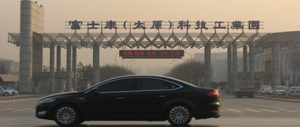A vigorous campaign to clean up pollution in electronics giant Apple’s supply chain, waged through 2011, ended up as one of the year’s hottest topics of public debate in China. With good reason: a series of reports published by a coalition of domestic green groups exposed serious violations at some of the company’s contractors and seized the attention of the global media. (See chinadialogue’s latest report on pollution in Apple’s supply chain, “Living with Foxconn”, for a detailed account of the friction between a factory and local community in Shanxi province.)
More profoundly, the campaign has signalled the emergence of an NGO-led consumer movement for China, in which civil society activists are helping the public to exercise oversight over the brands that produce their everyday products.
In January, Apple published its 2012 progress report on supplier responsibility. It’s an annual update, but this year there was something new: details of a set of special environmental audits that had been carried out at 14 of its suppliers. A member of Apple’s supply-chain responsibility team confirmed that these were prompted by questions from Chinese environmental groups, led by Beijing-based activist Ma Jun and his NGO the Institute of Public & Environmental Affairs (IPE).
Unlike Apple’s usual audits, these checks were carried out by third-party experts. More information was provided about the results, too: in contrast to last year’s report – which only included overall pass rates on six environmental measures (a total of 12 numbers) – the 2012 update provided a four-page summary of the specialised environmental audits, as well as more information than usual about the standard checks applied to the rest of the supply chain.
Air pollution was identified as the biggest problem, and in fact performance on this count was worse than the previous year. Only 68% of Apple’s suppliers were found to be complying with mandated standards, compared to 69% in 2011. Just 57% had air-pollution management systems in place, compared to 74% the previous year. Fifty-eight facilities were failing to monitor and control air emissions, while 77 lacked the procedures to do so.
Apple said that it is working with Chinese environmental groups to resolve these problems. And it has pledged to encourage its suppliers to publicise data on their environmental performance in the year ahead.
It sounds like major progress, and has been welcomed by environmental campaigners. Ma Jun said the “arrogance” Apple showed in the early days of the campaign, ignoring IPE’s approaches and hiding behind “commercial confidentiality”, has started to fade.
Interaction between the two sides has indeed stepped up, as two recent meetings show. In October last year, Ma visited San Francisco for what turned out to be a five-hour discussion with Apple executives. Apple made clear that it wished to maintain commercial confidentiality, while the environmental groups urged the corporation to press suppliers to make public statements about their environmental performance. “This way, they wouldn’t need to reveal their relationship with Apple and could protect confidentiality, but would allow a certain degree of public supervision of supply chain pollution,” said Ma.
Then, during the Chinese New Year holiday in January, Apple held a video conference with IPE and American campaign group the National Resources Defense Council (NRDC), which has long supported the Chinese campaign. At this meeting, Apple agreed to experiment with NGO-monitored environmental audits of its suppliers, Ma said.
Despite this progress, the Chinese groups argue that Apple’s demands on suppliers are still too weak. According to the information provided in the progress report, the most common response to environmental breaches was to ask the factory in question to make changes. In only two cases where auditors discovered “core violations” – the most serious breaches of compliance such as using a facility built without an environmental impact assessment – did Apple suspended business with the supplier.
And, while the company has shown itself willing to be more open than in the past, data gaps remain: the latest supplier report provides details on environmental violations, but not the names of the violators. Meanwhile, Apple is yet to make good on its promise to get suppliers to engage with environmental groups, said Ma.
Clearly, the battle with Apple is not over quite yet. Nonetheless in a struggle with a powerful corporation, Chinese NGOs have scored significant successes. And they are making global brands nervous.
IPE is also seeing better responses from Chinese factories than in the past. Since November 2006, some 560 companies have approached the organisation, wanting to explain the steps they are taking to address pollution – 218 in the past year alone. The first companies to get in touch were mostly well-known brands, but now most of the approaches come from suppliers to larger firms. “These are the manufacturers and processors,” said Ma. “They are the actual polluters.”
Corporate efforts to change the sweatshop image of Chinese factories aren’t new, but – the Apple example notwithstanding – have until recently come mostly from international brands, sensitive to global consumer preferences and keen to avoid legal battles and reputational risks. Moreover, such efforts have moved beyond the PR question – how best to present a company to the world – and into more substantive areas of verification and supply-chain management.
SGS, one of the world’s largest inspection, verification, testing and certification firms, started working in China 20 years ago. Xue Jian, head of the company’s environmental division, told chinadialogue his department has seen business double every year since it was founded in 2005. But most of its customers are foreign-owned: firms headquartered outside of China tend to take supply-chain management more seriously, he said. The most farsighted firms have set standards that are stricter than local laws require.
These firms are coming from a different context to China’s domestic outfits – that is to say, the countries where they are headquartered have an established culture of consumer supervision. For decades, environmental, labour and human rights campaigners have fostered a western consumer movement focused on “ethical consumption”: a preference for products that inflict no environmental or social harm, or at least less than other products on the market. Those campaigners lobby for legislation, press consumers to make ethical decisions and harness consumer power as a tool for holding corporations to account.
The shape of that movement today owes much to forces that took hold in 1960s and 1970s America. As wages rose, and the quantity of goods on offer grew, concerted and coherent consumer campaigning emerged, focused not just on consumer safety but also the wider ecological and social impacts of manufacturing and consumption. Outspoken individuals helped to catalyse a growing public consciousness: Rachel Carson’s 1962 book Silent Spring – which highlighted the impact of pesticides on birdlife – and Ralph Nader’s Unsafe at Any Speed (1965), an attack on the safety record of the automobile industry, spurred public debate about the potential harm of everyday products.
The movement’s growing clout was reflected in an expanding list of consumer legislation – from the 1966 Fair Packaging and Labeling Act to the 1969 Child Protection and Toy Safety Act – and its growing remit in the ever greater number of activist causes. Nader’s NGO Public Citizen, founded in 1971, acted as an umbrella group for projects focused on issues from air pollution to corruption. In 2011, the organisation had 225,000 members.
Public oversight in North America and Europe has also been exercised through direct action against corporations perceived to be unethical. From the boycott against Nestle for promoting breast milk substitutes in developing countries, launched in 1977, to the protests over labour conditions in overseas factories that dogged Nike throughout the 1990s, consumers have repeatedly proved their credentials as a check on corporate power.
But in China, consumer oversight has remained weak. The China Consumers’ Association (CCA) was founded in 1984 and has since established a Consumer Rights Day and a consumer hotline. But for 30 years, public participation has been limited to one-off cases, and the CCA remains very much an official body.
Now, China’s NGOs are changing the state of play, wielding pressure over polluters and providing the public with crucial data on manufacturers. In 2006, IPE created a pioneering map of water pollution in China, using publicly available environmental data to illustrate the geographical spread of the country’s environmental violations. This device allowed the organisation to monitor corporate polluters and, in turn, the Chinese supply chains of international brands. Today, Ma Jun is frequently compared to Rachel Carson for his role stoking a new kind of consumer consciousness.
IPE has since linked up with dozens of other Chinese NGOs to run a series of green consumer campaigns, encouraging Chinese shoppers to make “green choices”. They have also published lists of companies causing supply-chain pollution in the clothing and IT sectors.
This is how China’s consumer movement is being shaped. It is NGO-led, builds on government environmental protection work, and uses the media to advocate green consumer choices – choices that could change the way powerful companies manage their supply chains. The response of Apple, one of the biggest and most secretive companies in the world, shows just how seriously we should take it.
Meng Si is a Beijing-based freelance journalist, who formerly worked for chinadialogue.
Xu Nan is managing editor at chinadialogue’s Beijing office.
Homepage image by wZa HK


